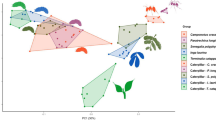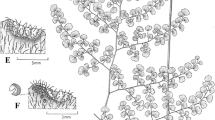Abstract
Cuticular investigations have been carried out in three species ofHemigraphis and nine ofStrobilanthes. The two genera belonging to the family Acanthaceae are generally placed together within the same tribe by taxonomists.Hemigraphis andStrobilanthes show broadly similar epidermal characters though there are significant differences also. On the basis of the present study, the placement of these genera in two different sub-tribes but under the same tribe appears to be justified. The three species ofHemigraphis show more or less uniform epiderma1 characters butH. colorata andH. hirta are more close to each other than toH. alternata.
The epidermal characters of the investigated species ofStrobilanthes, which fall within six of Bremekamp’s new genera do not indicate any striking dissimilarities which would help to separate them under the new genera of Bremekamp.
The variations recorded in the epidermal characters of different species of the two genera are sufficiently pronounced, as to justify their use in making distinctions at species level.
Similar content being viewed by others
References
Ahmad, K. J. ..“Cuticular studies in some Acanthaceae and Solanaceae,”Ph.D. Thesis, Lucknow University, 1972.
Anderson, T... “An enumeration of the Indian species of Acanthaceae,”J. Linn. Soc. (Bot.), 1867,9, 425–56.
Bentham, G. and Hooker, J. D.Genera Plantarum, Acanthaceae, 1876,2, 1060–1122.
Bremekamp, C. E. B... “Materials for a monograph of the Strobilanthinae (Acanthaceae),”Verh. Nederl. Akad. Wet. 2, 1944, Sect.41, 1–306.
—————.. “The delimitation of the Acanthaceae,”Proc. Koninkl. Nederl Akad. Wet. Amst., Ser. C, 1953,56, 533–46.
—————.. “Delimitation and sub-division ofthe Acanthaceae,”Bull. Bot. Surv. India, 1965,7, 21–30.
Chaubal, P. D. ..Palynological Studies on the Family Acanthaceae, Univ. Poona, 1966.
Clarke, C. B... “Acanthaceae,” In Hooker, J. D.,Flora of British India, 1884–85,4, pp. 387–558.
Lindau, G... “Acanthaceae,” In Engler, A. and Prantl, K.,Die natiirlichen Pflanzenfamilien, 1895,4, 274–354.
Nees Von Esenbeck, C. G... “Acanthaceae,” In De Candolle, A. P.,Prodromus Systematis Naturalis Regni Vegetabilis, Paris. 1847,11, 46–519.
Vishnu-Mittre and Gupta, H. P. “Contribution to the pollen morphology of the genusStrobilanthes Blume, with remarks on its taxonomy,”Pollen et Spores, 1966,8, 285–307.
Willis, J. C...A Dictionary of the Flowering Plants and Ferns, Seventh Ed., Revised, H. K. Airy Shaw, Cambridge, 1966.
Author information
Authors and Affiliations
Additional information
Communicatedby Dr. L. D. Kapoor,f.a.sc.
Rights and permissions
About this article
Cite this article
Ahmad, K.J. Cuticular studies in some species ofHemigraphis andStrobilanthes . Proc. Indian Acad. Sci. 79, 29–40 (1974). https://doi.org/10.1007/BF03045434
Received:
Issue Date:
DOI: https://doi.org/10.1007/BF03045434




